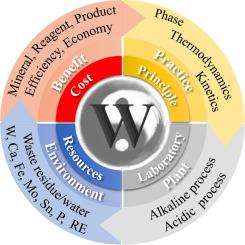Hydrometallurgy ( IF 4.8 ) Pub Date : 2022-06-15 , DOI: 10.1016/j.hydromet.2022.105928 Yuntao Lei , Fenglong Sun , Xuheng Liu , Zhongwei Zhao

|
As a strategic rare metal, tungsten is widely used in high-performance metallic materials like cemented carbide. The wet decomposition of scheelite CaWO4 and wolframite (Fe,Mn)WO4 is the primary and important step in tungsten metallurgy. According to the phase separation behaviors of the decomposition products, the wet decomposition processes of tungsten ore MWO4 (M = Ca, Fe, Mn) are summarized into four categories: the processes of producing 1) soluble M and insoluble W, 2) soluble M and soluble W, 3) insoluble M and insoluble W, 4) insoluble M and soluble W, each of which can derive specific decomposition methods with distinct characteristics. In thermodynamics, the equilibrium constant vs. temperature diagrams, predominance-region diagrams and phase diagrams of different acidic or alkaline decomposition methods were calculated and compared. In kinetics, the rate-determining step and targeted process intensification are analyzed and discussed, especially the phase separation/transformation of tungsten ore and decomposition products. Finally, the wet decomposition processes of tungsten ore are evaluated with respect to four aspects: principle and practice, laboratory and plant, resources and environment, and cost and benefit. The alkaline processes represented by the classical NaOH decomposition method and the acidic processes represented by the state-of-the-art H2SO4-H3PO4 synergistic decomposition method will jointly promote the vigorous development of the tungsten metallurgical industry.
中文翻译:

了解钨矿石的湿分解过程:相、热力学和动力学
钨作为一种战略性稀有金属,广泛用于硬质合金等高性能金属材料。白钨CaWO 4和黑钨矿(Fe,Mn)WO 4的湿法分解是钨冶金的首要和重要步骤。根据分解产物的相分离行为,钨矿石MWO 4的湿分解过程(M=Ca、Fe、Mn)归纳为四类:1)可溶性M和不溶性W,2)可溶性M和可溶性W,3)不溶性M和不溶性W,4)不溶性M和可溶性W的产生过程,每一种都可以推导出具有鲜明特征的具体分解方法。在热力学方面,计算并比较了不同酸性或碱性分解方法的平衡常数与温度图、优势区域图和相图。在动力学方面,对限速步骤和目标过程强化进行了分析和讨论,特别是钨矿石和分解产物的相分离/转化。最后从原理与实践、实验室与厂房、资源与环境、以及成本和收益。以经典的 NaOH 分解法为代表的碱性过程和以最先进的 H 为代表的酸性过程2 SO 4 -H 3 PO 4协同分解法将共同推动钨冶金工业的蓬勃发展。











































 京公网安备 11010802027423号
京公网安备 11010802027423号